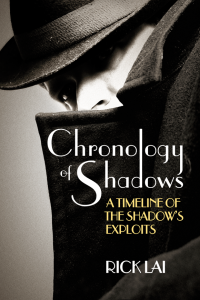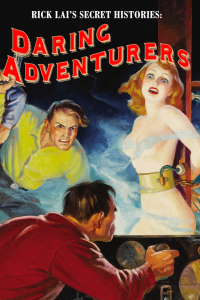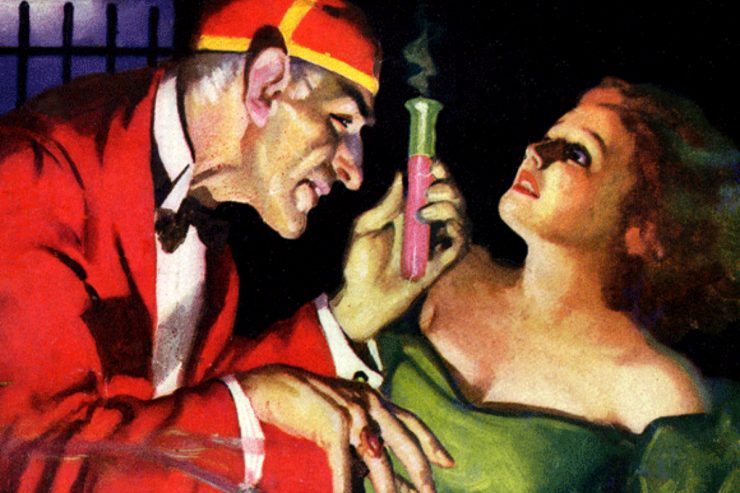Pulp magazines have influenced writers, artists, film directors, software developers, and countless others over the years. Our “PulpFest Profiles” focus on contemporary creators who have drawn inspiration from these rough-paper fiction magazines.
 William Patrick Maynard (WPM): The Shadow of Rick Lai has loomed large over the pulp world for nearly 40 years. From your earliest writings in fanzines, you combined a purist’s love of canonical chronology with speculative scholarship that used the Wold Newton Universe as a starting point to chart your own path. Your essays became the basis for four essential reference books that moved you to the forefront of pulp scholarship. These same reference works launched the second wave of your career: penning stories that you wanted to see written just the way you imagined them when filling in the gaps in chronologies. Let’s step back to how it all began. How did Rick Lai, first discover The Shadow and Doc Savage and all the rest?
William Patrick Maynard (WPM): The Shadow of Rick Lai has loomed large over the pulp world for nearly 40 years. From your earliest writings in fanzines, you combined a purist’s love of canonical chronology with speculative scholarship that used the Wold Newton Universe as a starting point to chart your own path. Your essays became the basis for four essential reference books that moved you to the forefront of pulp scholarship. These same reference works launched the second wave of your career: penning stories that you wanted to see written just the way you imagined them when filling in the gaps in chronologies. Let’s step back to how it all began. How did Rick Lai, first discover The Shadow and Doc Savage and all the rest?
Rick Lai: I became interested in Doc Savage due to the Bantam paperbacks with their stunning artwork by James Bama. I bought my first Doc Savage novel — The Thousand-Headed Man — in October 1967. I was twelve years old. By the time I was fifteen, I was reading paperback editions of the works of such pulp authors as Burroughs, Howard, Lovecraft, Mundy, E. E. “Doc” Smith, and Clark Ashton Smith. I didn’t get interested in The Shadow until I read Philip Josê Farmer’s The Adventure of the Peerless Peer in 1977. The pulp crimefighter meets Sherlock Holmes in that book.
WPM: There are so many celebrated names contributing to the labor of love called fanzines. At what point did you realize you had been called to write A Chronology of Bronze and A Chronology of Shadows? When did you know your essays demanded to be preserved in book form? Specifically, what made you separate from all the rest?
Rick Lai: In the eighties and nineties, I was writing extremely complex fanzine articles linking The Shadow and Doc Savage to other fictional characters as well as obscure historical events. I needed to write the chronologies to provide a logical background for my own articles. The first versions of the two chronologies were printed separately as fanzines by Tom and Ginger Johnson. The chronologies were always segregated from the other articles solely due to their length.
 The decision to preserve my works in book form can be credited to Matt Moring, the publisher of Altus Press (now known as Steeger Books). On his own initiative, Matt approached me about reprinting my articles. Matt’s offer was probably prompted by Win Scott Eckert’s posting several of my fanzine articles to the Wold Newton Family website. I owe both Win and Matt a great debt for their belief in my work.
The decision to preserve my works in book form can be credited to Matt Moring, the publisher of Altus Press (now known as Steeger Books). On his own initiative, Matt approached me about reprinting my articles. Matt’s offer was probably prompted by Win Scott Eckert’s posting several of my fanzine articles to the Wold Newton Family website. I owe both Win and Matt a great debt for their belief in my work.
WPM: You cover so much ground in Daring Adventurers and Criminal Masterminds. I first read a lot of this material online years before I ever met you. Then your books became essential references to me. As wide-reaching as they are, there’s always so much more material you could have covered. Anyone who has ever conversed with you has realized you could easily write an encyclopedia of pulp fiction, literature, film, etc. Do you have any ambition of adding additional volumes?
Rick Lai: I have a lot of articles that were originally written for PEAPS (the Pulp Era Amateur Press Society) and REHUPA (the Robert E. Howard United Press Association). There’s enough for two volumes. I just need to sort out the material before offering it to a publisher. One volume will deal with the interrelated myth patterns of H. P. Lovecraft and his correspondents. The other will feature pulp-era heroes and villains.
WPM: You’ve translated and adapted the first two Judex books into English. This is no easy task. Tell us a bit about how A Chronology of Shadows took you to Judex and your experience adapting European works? Did you see yourself as strictly interpreting the original author’s work or did you leave your personal mark as an author while adapting the books? What other foreign works would you want to see adapted?
 Rick Lai: Actually, my interest in French escapist literature led me to collect Walter Gibson’s Shadow novels. In 1975, I read Hugh Greene’s “Rivals of Sherlock Holmes” anthologies. Greene reprinted a couple of stories about Arsène Lupin, the master thief created by Maurice Leblanc. I became enthralled by the series, especially the idea of Lupin having multiple identities. Researching Leblanc’s Lupin tales led me to discover similar protagonists in French mystery fiction such as Emil Gaboriau’s Monsieur Lecoq, Fantômas (created by Marcel Allain and Pierre Souvestre), and Gaston Leroux’s The Phantom of the Opera. I was familiar with all those characters before reading my first two Shadow novels, “The Crime Oracle” and “The Teeth of the Dragon.”
Rick Lai: Actually, my interest in French escapist literature led me to collect Walter Gibson’s Shadow novels. In 1975, I read Hugh Greene’s “Rivals of Sherlock Holmes” anthologies. Greene reprinted a couple of stories about Arsène Lupin, the master thief created by Maurice Leblanc. I became enthralled by the series, especially the idea of Lupin having multiple identities. Researching Leblanc’s Lupin tales led me to discover similar protagonists in French mystery fiction such as Emil Gaboriau’s Monsieur Lecoq, Fantômas (created by Marcel Allain and Pierre Souvestre), and Gaston Leroux’s The Phantom of the Opera. I was familiar with all those characters before reading my first two Shadow novels, “The Crime Oracle” and “The Teeth of the Dragon.”
I learned about Judex by corresponding with Jean-Marc Lofficier, the publisher of Black Coat Press. My fascination with Judex stems from his visual resemblance to The Shadow. When Jean-Marc accepted my offer to adapt the two Judex novels by Arthur Bernède and Louis Feuillade into English, I mentioned to him several continuity errors and unanswered plot points in the text. With Jean-Marc’s approval, I altered the English text to fix these problems in the original novels.
Regarding new translations, I would love to see all the Doctor Mabuse books by Norbert Jacques translated from German into English. Only the first book in the series has ever been translated. I am particularly desirous of reading Engineer Mars in which the mastermind becomes involved with the aviation industry.
WPM: Tell us about your Shadows of the Opera series and how it relates to your work as a pulp historian. Is the series complete now? Is there any chance of the first book being reprinted?
 Rick Lai: The Shadows of the Opera series is my attempt to write a series of Farmeresque crossover tales that link the French mystery characters of the nineteenth century directly to the American heroes of the pulp era. There will be at least one more Shadows of the Opera book as well as another volume in the sequel series, Sisters of the Shadows. Once I have added a handful of new stories to the first volume, I hope to get it reprinted; probably within the next two years.
Rick Lai: The Shadows of the Opera series is my attempt to write a series of Farmeresque crossover tales that link the French mystery characters of the nineteenth century directly to the American heroes of the pulp era. There will be at least one more Shadows of the Opera book as well as another volume in the sequel series, Sisters of the Shadows. Once I have added a handful of new stories to the first volume, I hope to get it reprinted; probably within the next two years.
WPM: Tell us about Major Sabbath. Is there any more fiction yet to come from the pen of Rick Lai?
Rick Lai: Ron Fortier of Airship 27 Productions graciously gave me the opportunity to construct a “spaghetti Western” universe to which various writers — such as Erik Franklin and Frank Schildiner — could contribute. The central character, Major Sabbath, is an amalgamation of the various bounty hunters played by Lee Van Cleef in spaghetti Westerns. I wrote the introductory story to the first volume. Hopefully, when I finish the projects mentioned earlier in this interview, I can work on a second volume with Airship 27. I would love to write a story teaming up Major Sabbath with Ana Sartana, a female gunslinger inspired by Raquel Welch’s Hannie Caulder.
WPM: Rick, thank you for your time. This has truly been a pleasure
Rick Lai’s CHRONOLOGY OF SHADOWS is a timeline of The Shadow’s adventures, while his DARING ADVENTURERS (featuring cover art by George Rozen) is a collection of articles concerning a number of characters, including The Avenger, El Borak, Jules de Grandin, Peter the Brazen, Sherlock Holmes, and Singapore Sammy. Both were originally published by Altus Press and are currently available through Steeger Books.
In 1917, silent film director Louis Feuillade and writer Arthur Bernède created the character of a mysterious avenger, wearing a slouch hat and a dark cloak — Judex! His name means “Judge,” and he has sworn to mercilessly punish criminals! Sound familiar? Adapted by Rick Lai, JUDEX is available through Black Coat Press. Actor René Cresté appears on the front cover.
Rick Lai’s SISTERS OF THE SHADOWS 2: THE CAGLIOSTRO CURSE, recounts the brutal vendetta between two women, a merciless decades-long war which involves the greatest gunslingers of the American West, the most dangerous assassins of Europe, the terrifying Fantômas, an immortal sorceress, and the ruler of all vampires, Count Dracula! It’s also available through Black Coat Press and features cover art by Amar Djouad.
William Patrick Maynard is the licensed continuation author for the Sax Rohmer Literary Estate. His short fiction has been published in anthologies by Airship 27, Bold Venture Press, Black Coat Press, Edge Publishing, Flinch Books, MX Books, Riviere Blanche, and Titan Books. He has authored over 250 articles for numerous magazines and websites. He has contributed Blu-ray commentary tracks and produced bonus features for releases by MGM, Shout Factory, Kino Lorber, and The Serial Squadron. Bill is on the editorial board of The Battered Silicon Dispatch Box and is a member of the PulpFest Organizing Committee where he serves as Assistant Director of Marketing and Afternoon Programming Director. He resides in Northeast Ohio.






